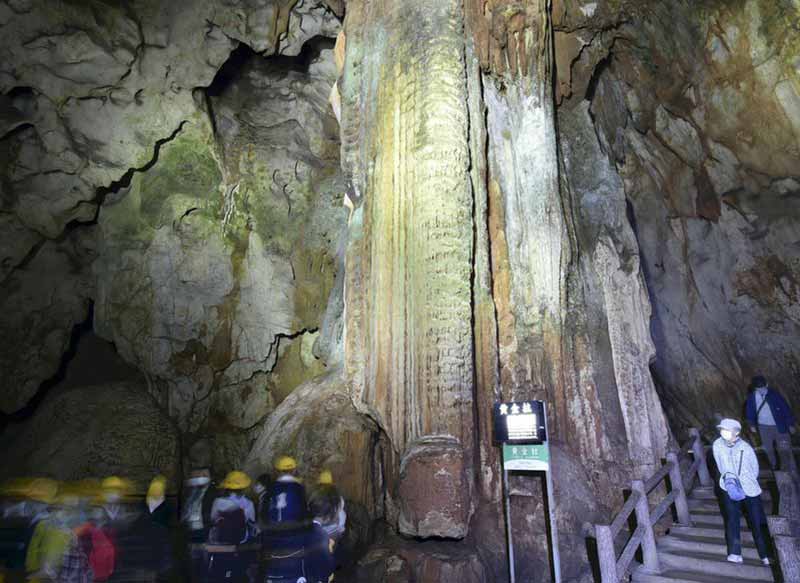
A greenish hue is seen on the giant stalactite Koganebashira in Akiyoshido cave in Mine, Yamaguchi Prefecture, on Nov. 11.
November 28, 2021
MINE, Yamaguchi — Going green has taken on another meaning in a cave illuminated by LEDs.
Some milky white stalactites are turning green in Akiyoshido — one of Japan’s largest limestone caves — in Mine, Yamaguchi Prefecture.
Experts say lights installed to illuminate the natural formations prompted the growth of algae and bacteria that prefer the LED wavelengths.
The Mine city board of education is working hard to take countermeasures against the discoloration out of concern the deterioration could negatively impact the ecosystem of the cave, which was designated a special natural monument by the central government in 1952.
The limestone cave stretches beneath the karst plateau Akiyoshidai. The total length of the cave is over 10 kilometers, of which about 1 kilometer is used as a sightseeing course, illuminated from along the path and overhead.

In a photo taken around 2004, Koganebashira is seen before the discoloration.
Many stalactites have since turned slightly green, especially where they have been exposed to the light many times. The giant stalactite Koganebashira (Golden pillars), which is about 15 meters high, is particularly discolored.
Changes to the color were first noticed in 2011, one year after LED lighting was installed in about 200 places in the cave to replace mainly fluorescent lighting, according to the board of education.
The board set up a task force made up of six experts in 2019 and has been investigating the issue for about 2½ years.
The research results were reported to residents on Nov. 8, stating the wavelengths of LED lighting in the cave contain more blue and orange light, which allows the spread of algae and bacteria that thrive in these conditions.
The spread of these microorganisms was seen at 117 of about 130 locations that are equipped with footlights. Because nutrient salts derived from bat excrement accumulated in those locations, the experts said the organisms can survive in the cave as long as they have light.
The experts concluded that the stones should not have prolonged exposure to light and said rinsing off the nutrient salts was effective. Wiping the stone down with a solution of sodium hypochlorite was also effective in removing algae and other organisms.
Depending on the concentration of sodium hypochlorite, however, the solution may kill not only the organisms causing the discoloration, but also unique creatures found only in this cave. These include Sinella akiyoshiana, a special kind of insect akin to springtails that is an endemic species that must be protected.
The Mine city government will apply to the Cultural Affairs Agency for permission to implement the methods to remove the algae and bacteria and control their spread. The methods will be tested for two years starting in April 2022 to verify their effectiveness.

“Each method has its own advantages and disadvantages,” said Kazuhisa Yoshimura, a professor emeritus at Kyushu University.
The geochemistry expert, who chairs the task force, added, “Effective methods vary from place to place, and suitable methods need to be continuously used.”
Cases throughout nation
Across the country, Limestone caves open to tourists are facing the same problem and are taking measures to combat it.
Moss and algae have grown around the LED lights at the Ryusendo cave, a national natural monument in Iwaizumi, Iwate Prefecture. The cave office staff remove them with sponges, taking care not to damage the limestone, during daily safety inspections. The underwater lights are also covered with algae that is periodically removed after pulling the lights out of the water and cleaning them.
At the Gyokusendo cave in Nanjo, Okinawa Prefecture, work is underway to illuminate the cave with a low amount of light by filtering the fluorescent lights and indirect lighting using LEDs. In addition, about 20 staff members clean the cave once a month using a diluted sodium hypochlorite solution for several hours.
People involved in the management of the Ryugado cave in Kami, Kochi Prefecture, are plagued by the same problem.
“If you scrub it with a soft brush, it will come off, but it will soon grow back,” said Kinichi Okamura, the head of Ryugado Cave Preservation Association. “We’re caught in a vicious cycle.”
AkiyoshidoRelated Tags
"Features" POPULAR ARTICLE
-

Sanrio to Open Museum in Yamanashi Pref. Dedicated to Founder, Exhibits Include Hello Kitty, Other Characters
-

Autumn Foliage Surrounds Visitors to Tokyo’s Showa Kinen Park
-

My Daughter No Longer Speaks to Me, But I Want to See Her and My Grandchild
-

Kumamoto: Public Bath Refurbished as Library Where You Can Chat, Take Photos
-

Frozen Vegetables: Demand Rises for Convenient, Tasty Domestic Produce
JN ACCESS RANKING
-

Keidanren Chairman Yoshinobu Tsutsui Visits Kashiwazaki-Kariwa Nuclear Power Plant; Inspects New Emergency Safety System
-

Imports of Rare Earths from China Facing Delays, May Be Caused by Deterioration of Japan-China Relations
-

University of Tokyo Professor Discusses Japanese Economic Security in Interview Ahead of Forum
-

Japan Pulls out of Vietnam Nuclear Project, Complicating Hanoi’s Power Plans
-

Govt Aims to Expand NISA Program Lineup, Abolish Age Restriction






















